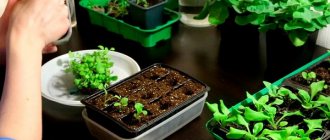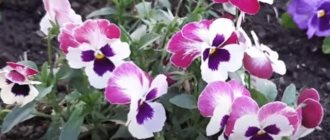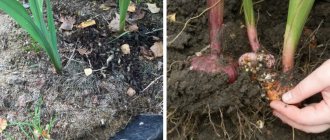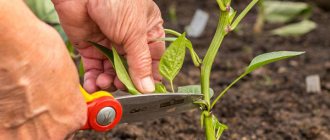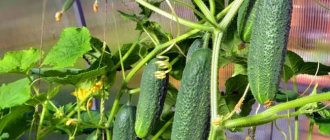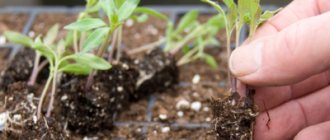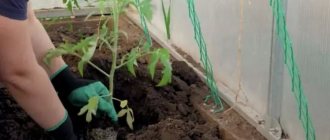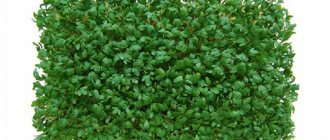What is it and what does it look like: description and photo
Orchid babies are small shoots on peduncles at the root collar or stem. Within six months they grow and develop, putting out leaves. As soon as the shoot becomes large, it is carefully disconnected from the mother tree and transplanted into a separate pot.
The photo shows what baby orchids look like:
Is it possible to separate the baby from the flower if it is blooming?
When the plant blooms, it is not advisable to separate the shoots. Having disturbed a flower, it is not known how it will react to such actions. But there are hybrids that bloom endlessly. A flowering plant grows children that develop, and the peduncle, shedding some flowers, immediately forms new buds.
If the cutting is already more than 4-5 months old, it has formed roots 6-7 cm long, has 4 leaves, then it can be disconnected from the mother bush even during the budding period. You should also pay attention to the condition of the adult flower; if it is sick, it is better not to disturb it and wait until it recovers.
You don’t have to separate the shoot from the mother bush; it won’t “eat” the parent. The layering root system is already capable of feeding on the substrate on its own. We must not forget to feed and water the orchid. It is advisable to transplant the overgrown plant into a larger pot so that everyone has enough space and soil.
How does it appear on the stem?
It is very easy to distinguish a new plant from an old one. The future orchid is formed from irregularities located on the stem - dormant buds.
If a flower has sprouted a shoot on the trunk, then first thin white shoots (sticks) begin to extend from the base. They increase in size over time. The buds gradually swell, from which leaves will appear in the future. The roots are the last to form.
In the first 10 days, it is difficult to determine what will develop from the swollen bud. It is important to pay attention to the tip: if it is slightly pointed, then a flower will grow, if it is blunt, then a baby will grow.
Formation methods
The baby appears on the peduncle after the flowering stage. It begins its development from dormant buds - small tubercles with a scaly coating on the stem. However, exceptions are possible: sometimes the cake can ripen from the axil of leaves and on the roots.
Children are produced by monopodial orchids (Vandas, Phalaenopsis, Ascocentrum). Some types of sympodial orchids (dendrobiums, paphiopedilums) are also capable of raising children.
How long does it take to “mature” before separation?
The young plant must be next to the “mother” for at least 6 months. However, in each case individual conditions should be taken into account:
- climate;
- growth rate;
- variety.
There are a number of main signs by which you can determine that the time has come for a child to start living independently:
- the roots of the branch are five cm deep and have at least three roots;
- five to six leaves have formed on the plant;
- the baby should be a rich green color (without rot and dry parts).
If you are not completely sure that it is time to plant the orchid offspring, it is better to wait. According to experts, the baby can develop on the main flower within 12 months.
Purpose of appearance
The main purpose of the appearance of a baby is reproductive; the plant thus produces offspring and tries to prolong life. Propagation of orchids by children appearing on the arrow is one of the most popular methods of propagating certain types of orchids at home among gardeners.
Before raising a baby, you need to know what to do when an orchid has released a peduncle, and also how to force an orchid to produce several peduncles if it is stubborn and does not produce even one.
Why might a flower not sprout?
Some plant species do not reproduce by children. Sometimes new shoots do not develop due to improper care and growing conditions of the “mother” flower. There are a number of rules that experts advise to follow:
- the orchid should not touch cold windows;
- It is better to place a flowerpot with a flower in a warm place where there are no drafts;
- the optimal temperature for growth and development is + 20-28 degrees Celsius;
- air humidity should be about 85%;
- In winter, it is advisable to create additional lighting (at least 13 hours a day).
In the summer, jars of water can be placed around the orchid, and in the cold season, the radiators should be covered with damp towels to maintain the desired indoor climate.
Conditions of appearance
In order for babies to form on the arrow of the orchid, after the plant has finished blooming, it is necessary not to cut off the peduncle completely (read about what to do with the arrow when the orchid has already bloomed). It should simply be shortened, the cut point is 2 cm above the “sleeping” bud. In addition, the plant must be provided with a sufficient amount of intense light, which awakens the bud from sleep, and a high temperature regime.
Reference. If after flowering the arrow is left untouched, the orchid can “dry” it completely in order to save nutrients.
Find out in this material whether you should worry if the peduncle of an orchid has dried up and what to do in such a situation.
The cut must be made with a disinfected pruner. This must be done with great care, as the trunk and leaves of the plant can easily be damaged. In addition, if any hangnails or roughness remain, this can lead to the orchid becoming infected with infectious diseases. It is recommended to treat the cut area with cinnamon or crushed activated carbon.
A visual video on how to stimulate the appearance of a baby on a peduncle after the orchid has bloomed:
Step-by-step care instructions
If you decide to start breeding orchids, you need to study the factors influencing the formation of children, as well as the rules for caring for future plants.
If the process is missing
Shoots do not always grow on their own. Sometimes they need to be properly stimulated for the flower to begin to reproduce. There are several proven methods that even novice gardeners can use:
- cut off the peduncle at a distance of 2 cm from the bud;
- place the pot on the balcony or windowsill (spring-summer period);
- choose a warm place for the plant;
- applying cytokinin paste to the kidney (you must first make a small scratch or remove dried scales);
- fertilizing with nitrogen every two weeks.
How to care for it as it grows?
In order for a small plant to develop successfully, it is important to monitor the maintenance of comfortable living conditions for it:
- water an adult orchid when the ground becomes dry;
- wipe the leaves from the underside at least three times a week;
- fertilize after flowering ends;
- Avoid using dry fertilizers.
It is necessary to apply fertilizing 30-40 minutes after watering. For the first time, it is better to take half the dose, and then gradually increase it.
How to take it?
As soon as the small plant has formed, it must be separated from the “mother” flower and replanted. It is important to make sure that the roots of the baby are large enough and will be able to feed on their own.
If there is no doubt about this, you should take a sharp knife and cut off the shoot. It is best to treat damaged areas with crushed activated carbon, which will prevent infection.
The baby needs to be placed in an aqueous solution of potassium permanganate. A small orchid is planted in a pot with drainage. There is no need to compact the soil. It is advisable to cover the roots with a special substrate.
You cannot cut off all the shoots at once if the plant has several of them. Numerous damages can lead to the death of the flower. Children should be removed as the wounds from previous cuts heal.
From the video you will learn how to properly plant a baby orchid on a peduncle:
How to grow roots?
Roots are the pride of an orchid and an indicator of its viability. To activate their growth, you can use several types of solutions:
- Kornevin;
- Heteroauxin;
- honey with water;
- honey with aloe juice.
Experts advise using sphagnum moss to stimulate the root system after transplantation. To achieve the desired effect, it is important to follow the correct sequence of actions:
- soak the moss for 30 minutes, let it swell;
- install a support, fix the plant;
- spread moss on top of the substrate;
- cover with film (don’t forget to ventilate);
- Spray with water every day;
- use fertilizer once a week.
The first watering after transplantation is carried out no earlier than 4-5 days later.
How to speed up the growth of the roots of a baby orchid on a peduncle, learn from this video:
For what reasons do orchids have no babies?
If the orchid was grown incorrectly or was poorly cared for, then the cuttings may not appear at all or will turn out to be underdeveloped, with no roots. The nutrition and maintenance of the mother bush is reflected in the growth of shoots and their number.
Reasons why there are no layers:
- Lack of lighting affects the development of children. The length of the day should be 10-12 hours. The light needs to be diffused; the plant should not be in direct sunlight. In winter, when the days are short, additional lighting is installed.
- Lack of fertilizers, wrong composition, or excess fertilizing. Without fertilizers, the orchid will not be able to supply itself and its shoots with nutritional components, but overfeeding will also have a bad effect on the children.
- Lack of moisture will cause even the rudiments of layering to dry out. If the water does not arrive on time, the mother plant will dry out, then we are not talking about any children, the orchid itself will have to be saved.
Stress and unfavorable conditions also force the orchid to form a new plant. Especially when this threatens her life, the flower insures itself by leaving offspring for further reproduction. Such layerings do not develop roots for a long time and take root with difficulty.
Factors for the appearance of shoots in an orchid:
- dying off of the growing point;
- trunk damage;
- drought;
- development of a peduncle from the center of the rosette.
